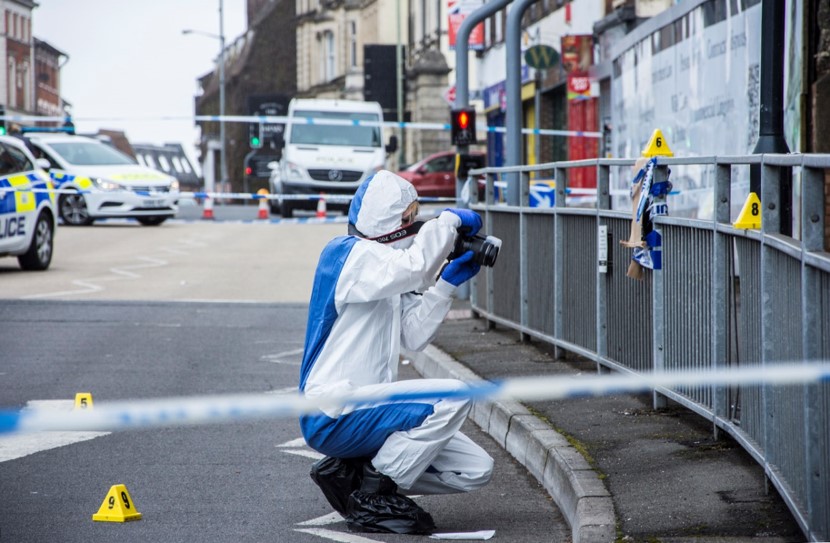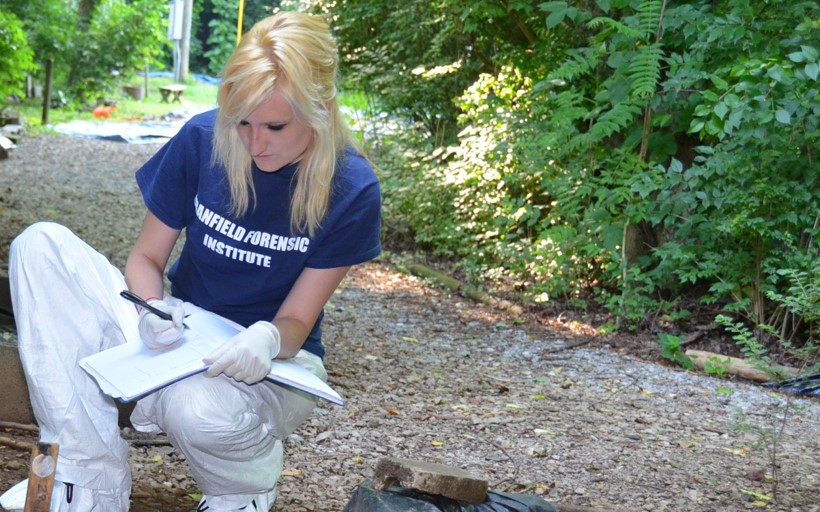Being a real life crime scene investigator: Blog 1 – Life before Cranfield
11/12/2018

The first crime scene I ever attended was on a hot summer’s day in 2012: a male living alone in a storage facility, decomposed beyond facial recognition and in the perceptible ‘bloat’ stage of decomposition. I noted observations of the body and searched with two medico-legal death investigators around the plethora of possessions contained in his small property, for the missing pieces of the puzzle: Who was this man? How long had he been deceased? Why did he die?
I had just graduated from the University of Leeds with a first-class BSc in Medical Sciences which I had completed in two years of study after a direct transfer into the second year and was spending six weeks of my long summer on a unique, hands-on ‘Forensic Investigations and Autopsy Internship’ at a Medical Examiner’s Office in the city of Pittsburgh, United States.
“How are you feeling?” the investigator quizzed me as I stepped over another a pile of litter to obtain a closer view of the body, notepad and pen in hand. The heat combined with the decay in a poorly ventilated, confined space presented one of the more challenging first scenes to be exposed to. I remember feeling glad I had eaten a full breakfast that morning, but I felt fine. I helped the investigators recover the deceased into a body bag and carried the bags of seized evidence back to the van, anticipating the morning autopsy examination where the final clues would be solved.
I had always been fascinated by the internal workings of the human body and was particularly gripped by anatomical dissection in my undergraduate degree. So much so, that I spent the first half of my postgraduate summer volunteering at a University’s Anatomical Sciences Dissection Laboratory preparing prosections for medical teaching and assisting with the embalming of new donations. It was during my first week while working at the embalming station below the dissection lab that I noticed hundreds of brown boxes stacked on shelves. I remember enquiring as to what was contained inside them and learned that they were the University’s donated skeletal collection used for medical education.
When I returned the next morning, I approached the Senior Lecturer of Anatomical Sciences with a project idea to create an inventory of their entire skeletal collection. I borrowed a standard human bone manual from the University library and then spent the next seven weeks teaching myself to identify, side and record over 6,000 human bones and developed an electronic database that could be used by the University for the receipt of all future skeletal material. Working long days to complete the project, I rapidly developed an aptitude for skeletal anatomy and became intrigued by the expression of different pathologies present on the bones and the variance between human skeletons.
It was during this time that I started to research possible careers in identifying human remains and came across the field of ‘forensic anthropology’. The term ‘forensics’ was not foreign to me. I had first joined the police when I was on my gap year at 19 years old and my first job was working in an administrative role in a Fingerprint Bureau where I was responsible for maintaining the hardcopy National Fingerprint Forms before leaving to pursue my undergraduate Medical Sciences degree. I began researching a way to combine my long-standing interest in forensics with my passion for the study of bones, which led me to the Cranfield University website advertising their MSc in Forensic Archaeology and Anthropology. At the time, I was also considering entry to postgraduate medicine with the aspiration of becoming a forensic pathologist, but decided that the master’s degree was more attractive because it could provide me with a quicker entry route into specialised postgraduate study of human bones, a future stepping stone for employability in the competitive field of forensics, and further academic opportunities in studying for a PhD.

My reasons for choosing Cranfield’s MSc accredited Forensic Programme were four-fold. Firstly, it was one of very few UK universities to offer the dual study of archaeology and anthropology, with the added benefit of being taught by some of the UK’s leading experts in the field. Secondly, the broad range of option modules offered a distinct opportunity to tailor my MSc to meet other areas of forensics I was interested in – such as mass fatality incidents and fire investigation – while still maintaining a specialist degree. Thirdly, the unique format of modules of five-day duration appealed to my learning style of being able to indulge into the study of one topic at a time, logically structured to follow the theme from crime scene to court room. Finally, I felt that the MSc Forensic Archaeology and Anthropology programme offered a strong emphasis on experiential learning with practical laboratories and simulated exercises throughout.
Before finalising my decision to pursue the MSc in Forensic Archaeology and Anthropology, I endeavoured to gain practical experience into the wider forensics field and applied for the internship in Pittsburgh. I was the first UK participant of their programme and spent six long weeks with medico-legal death investigators, attending scenes of homicides, suicides, accidental and unexplained deaths.
The high volume of cases attended every day by the Medical Examiner’s office equipped me with a wealth of experience in interpreting scenes of crime, forensic photography, and the search, identification and collection of evidence. I was then able to follow each case through to a morning autopsy examination where I worked with forensic pathologists to conduct hands-on evisceration of organs, collection of toxicological and histology samples and acquired knowledge of different causes and manners of death. The investigative nature of the work only reiterated my passion for this career. When I returned to the UK, I was certain I wanted to pursue the MSc in Forensic Archaeology and Anthropology at Cranfield to further enhance my foundation knowledge, and I was readily accepted for the 2012/2013 intake.
To be continued…
Categories & Tags:
Leave a comment on this post:
You might also like…
Preparing your work for Turnitin submission
Before submitting your work into Turnitin for similarity checking, if you have used referencing software then you may need to take some important steps first. Mendeley and Zotero integrate with MS Word by embedding field ...
The fast track to supercar engineering: My Cranfield journey
It’s been a dream come true to work on some of the world’s most prestigious supercars – the Aston Martin Valhalla, McLaren 750 & Artura, the GMA T.33. But every successful ...
Automotive Engineering: From student to hypercar innovation at Rimac
We sat down with recent graduate Thomas Perrin, to discuss how his year on the MSc in Automotive Engineering at Cranfield University propelled him from the lecture hall directly into the ...
What this year at Cranfield really meant to me
Every Cranfield journey is unique. In this alumni reflection, Zachea Scicluna shares what her year at Cranfield truly meant, from facing uncertainty to gaining hands-on experience in industry-backed projects. I’ve been reflecting (and delaying) ...
Preparing for assignments and exams?
Sorry! We know it seems a bit mean to mention the exams in January rather than looking forward to the break before it! However, we know many of you will be thinking about your forthcoming ...
Screening for FTSE 100 companies on Bloomberg
So you’re researching an index and need some data on its constituent companies? Bloomberg’s Equity Screening tool makes light work of this, not just for the FTSE, but for indices, exchanges and sectors worldwide. Type EQS ...







Nice to read the blog of a crime scene investigator and its nice to know about you. Our nature of work in similar you work as crime scene investigatory and we clean up crime scenes –
real life crime scene invastigator is one of the best platform to go through. thanx for sharing your valuable blog here